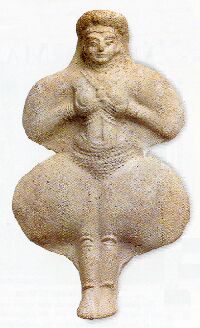return to Home Page
or move on to Goddess Epona, next chronologically,
or use Her Cyclopedia Index
Ishtar, Light-Giving.
E$T*
[to Whom the seventh day of November, day 311, is dedicated]

return to Home Page
or move on to Goddess Epona, next chronologically,
or use Her Cyclopedia Index
Ishtar, Light-Giving.
E$T*
[to Whom the seventh day of November, day 311, is dedicated]

Geography/Culture: Mesopotamia: Babylonia, Akkadian, Assyria. A Semitic overthrow of Sumeria occured in 2360 BC. References to Ishtar occur at least as early as 1850 BC in Nineveh. From Her temple in Erech (built or restored approximately 2700 BC), Her worship spread through Babylonia and Assyria. She was also recognized in Egypt.
Linguistic Note: Her name may be derived from that of the warlike astral god of the desert, Athar. Or his from Hers of course.
Description: Queen of heaven and earth; Benevolent Goddess of fertility, vitality in general, the moon, music, song, healing and sexuality; Life-giving power; Mother of Deities; Begetter of all; Source of all life; Personification of nature; the Star from Whose vulva flows all life; She Who represents the life which leads to death and rebirth; Queen of Nineveh; Ever virgin Warrior; Lustful-one; Divine wanton; the Promiscuous; the Compassionate Prostitute; Mother and Guider of humanity; anciently wise Judge and Councellor; Lady of prophetic vision; Star of prophesy; Mistress of the winds.
Invocations, Pleas, Hymns and Other Homage to HER: Ishtar
To Whom Sacred: branches; date-palm; bird; dog; lioness (on which She rides); lion; heifer/bull, especially the horns; mountains; the planet Masat (ie Venus); lapis-lazuli; vulva; wine; double-serpent sceptre; bow and arrows; scimitar; gold 8-pointed star (which equals guiding light); mushrusshu dragon.
Her holy women are called Ishtaritu, or Qadishtu). They take lovers from temple visitors as an expression of the sacredness of sexuality, 'the gift of Ishtar'. Her priests, Kurgarru, or Ishinu were self-castrated {seems rather contradictory}.
Festival: originally annual male human sacrifice which became modified to cutting off locks of hair. Shapatu, the night of the full moon when special offerings of food and drink were made to Her and celebration filled the temples.
Iconography: She wears a long-flounced garment, tiara-crown, a 6-stranded necklace, and has an insignia on Her shoulder; Her right-hand is upraised in a gesture of recognition or salutation.
Male Associates: consort, (in Assyria) Assur. Anu is also called Her consort. She is sometimes associated with Marduk. Son, Tammuz.
Gingira, ----.
Istar.
Istaru, .
Sharrat-Shame, Queen-of-Heaven, as the full moon.
Shaushga, ----.
Ulsiga, She-of-Heaven-and-Earth.
Zanaru, Lady-of-the-Lands.